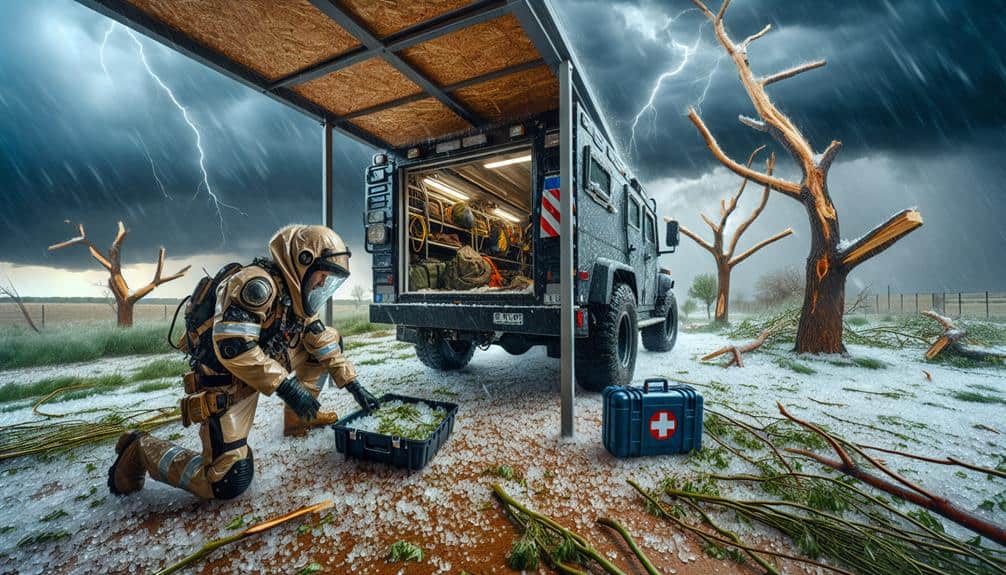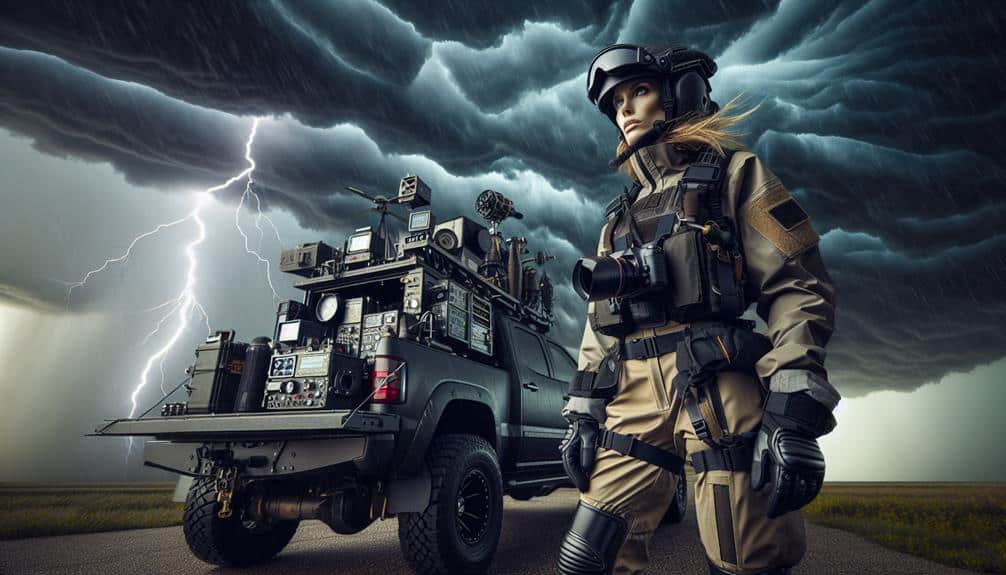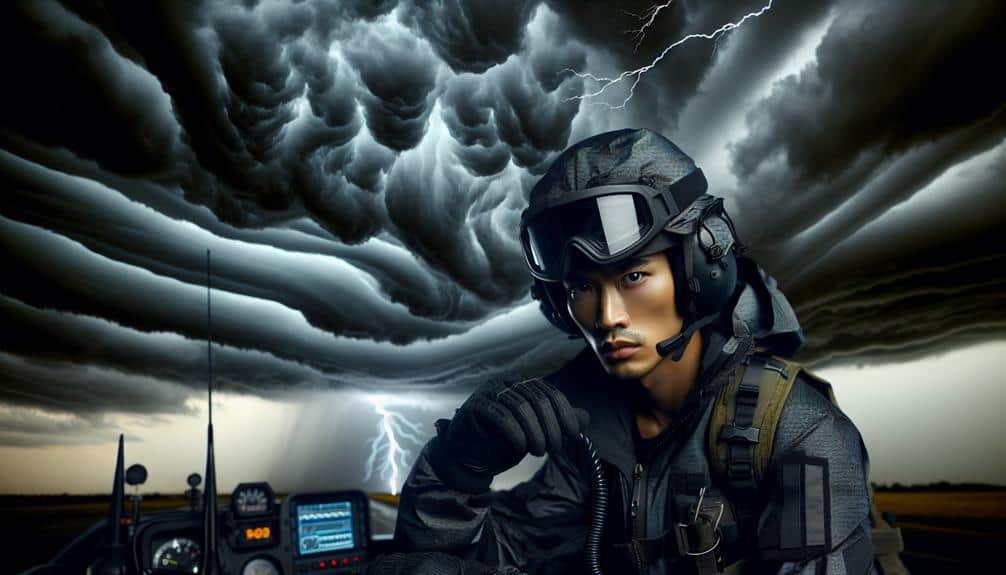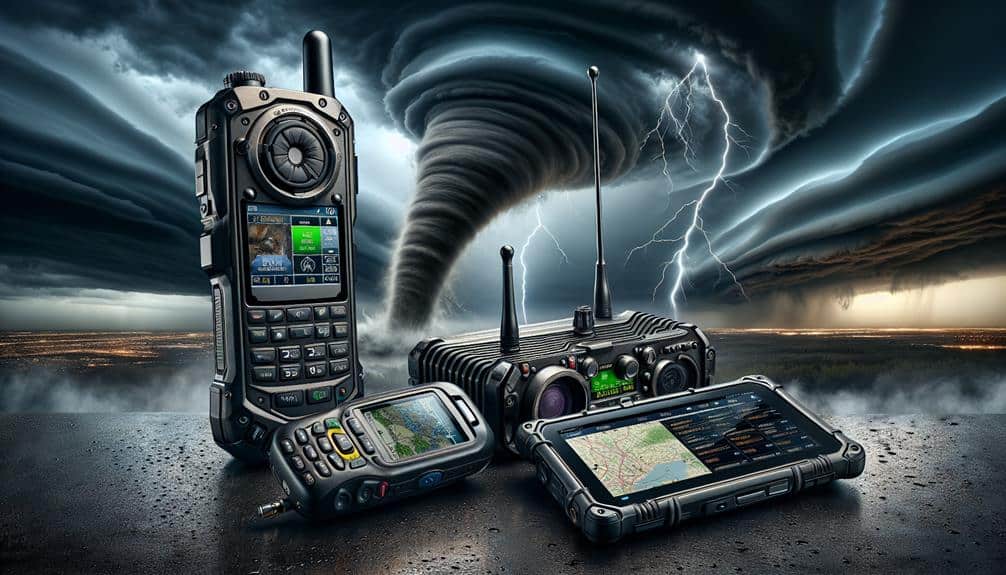When chasing storms, we prioritize wearing high-impact-resistant helmets and goggles, protecting against hailstones that can reach 100 mph. We reinforce our vehicles with metal roofs and polycarbonate window shields, reducing damage by up to 70% and 90%, respectively. Using satellite phones and emergency apps guarantees we receive real-time updates. We leverage Doppler radar and GPS-enabled devices for accurate storm tracking, positioning our vehicles safely. Post-storm, we assess damage and check equipment functionality. By following these data-backed measures, we greatly minimize risks and stay informed. Explore further to understand all the nuances of storm-chasing safety in hailstorms.
Key Points
- Wear high-impact-resistant helmets, goggles, and body armor to protect against hailstones.
- Reinforce vehicle roofs with metal or composite materials and use hail blankets.
- Use satellite phones and emergency apps for reliable communication and real-time weather updates.
- Track storm movements with Doppler radar and maintain a safe distance of 500 meters from the storm's core.
Essential Protective Clothing
When storm chasing during hailstorms, we must prioritize wearing high-impact-resistant helmets and goggles to protect against head and eye injuries. Data shows that hailstones can reach speeds up to 100 mph, making helmet protection crucial. High-impact-resistant helmets provide an integral barrier, reducing the risk of concussions and severe head trauma. Eye goggles, specifically those rated for high-impact activities, are equally essential. They prevent corneal abrasions and other eye injuries, ensuring we maintain clear vision to navigate safely.
Additionally, body armor is a pivotal component of our protective gear. Studies indicate that hailstones can cause significant bodily harm, including fractures and deep bruising. By wearing body armor, we mitigate these risks, ensuring our torsos are shielded from direct impact.
Gloves are another indispensable part of our gear. According to storm chaser injury reports, hand injuries are prevalent due to the vulnerability of our hands during severe weather conditions. Durable, impact-resistant gloves can prevent cuts, fractures, and other injuries, allowing us to handle equipment safely.
Vehicle Reinforcement Strategies
As we safeguard our bodies with protective clothing, we must also fortify our vehicles to withstand the intense impact of hailstorms. Data shows that hailstones can reach speeds of up to 100 mph, necessitating robust vehicle reinforcement.
First, let's consider roof protection. We can install reinforced roofing materials such as metal or composite roofs, which are more resistant to hail impact compared to traditional materials. Alternatively, hail blankets made of high-density polyethylene can provide an additional layer of protection. Evidence suggests that these materials can reduce roof damage by up to 70%.
Next, we need to focus on window shields. Windshields and side windows are particularly vulnerable during hailstorms. Installing polycarbonate window shields can help mitigate damage. Polycarbonate, a material 200 times stronger than glass, absorbs impact energy, thereby preventing shattering. Research indicates that polycarbonate shields can decrease the likelihood of window breakage by 90%.
Emergency Communication Tools
Effective emergency communication tools are essential for storm chasers to maintain contact and guarantee safety during hailstorms. Satellite phones, with their ability to operate independently of terrestrial cell towers, provide reliable communication in remote areas where cellular networks fail. According to the National Weather Service, satellite phones maintain a 99.9% connection rate even in severe weather conditions, making them indispensable for our expeditions.
Emergency apps serve as another critical tool in our arsenal. These applications can provide real-time weather alerts, GPS tracking, and direct access to emergency services. For instance, the FEMA app not only sends up-to-date weather warnings but also offers safety tips and emergency checklists.
Additionally, apps like Zello turn our smartphones into walkie-talkies, allowing instant voice communication with team members even when traditional networks are down.
Data from the Storm Prediction Center shows that using both satellite phones and emergency apps increases our chances of receiving timely updates and effectively coordinating rescue efforts. When we're out in the field, these tools provide the communication freedom we need to react swiftly and safely.
Incorporating these technologies guarantees we're never out of touch, even in the most adverse conditions.
Safe Observation Practices
Adhering to safe observation practices during hailstorms significantly reduces the risk of injury and equipment damage. First, we need to employ robust observation techniques. Utilizing Doppler radar data and satellite images helps us to track storm movements accurately. By constantly monitoring storm progression, we can make informed decisions on safe vantage points.
Next, incorporating strict safety precautions is essential. Positioning our vehicles on the leeward side of sturdy structures provides a shield against hail impact. We should also make sure our vehicles are equipped with reinforced glass and maintain a minimum safe distance of 500 meters from the storm's core.
Conducting a thorough risk assessment before and during the chase is vital. Evaluating the storm's intensity and trajectory enables us to anticipate potential hazards and adjust our positioning accordingly. Relying on real-time updates from meteorological services enhances our situational awareness.
Storm tracking is another important aspect. By using GPS-enabled devices, we can keep precise records of our location relative to the storm. This data-driven approach not only enhances our safety but also contributes to our research efforts.
Post-Storm Safety Measures

After the hailstorm subsides, conducting a thorough damage assessment of our vehicles and equipment is important to safeguard continued operational readiness. We should evaluate the structural integrity and functionality of our gear, securing we can respond efficiently to the next event.
First, let's identify viable shelter options for temporary protection against any subsequent storms. Effective shelter options range from reinforced garages to designated storm shelters, designed to withstand severe weather conditions.
Next, we need to prioritize debris cleanup. Clearing pathways not only facilitates smoother operations but minimizes potential hazards. Debris can conceal sharp objects or unstable ground, posing risks to our safety and vehicle integrity.
Let's follow a systematic approach:
- Vehicle Inspection: Check for windshield cracks, tire damage, and body dents. Immediate repairs can prevent further deterioration.
- Equipment Check: Verify the operational status of cameras, communication devices, and meteorological instruments. Replace or repair damaged items promptly.
- Shelter Options Assessment: Identify and document safe locations for future use. Emergency preparedness is key.
- Debris Cleanup: Remove fallen branches, shattered glass, and other obstructions. This ensures safe movement and reduces injury risks.
Frequently Asked Questions
How Can I Predict the Size of Hailstones During a Storm?
We can predict hailstone size by using hailstone measurement techniques like radar reflectivity and dual-polarization radar. Combining these with hailstone impact assessment methods, we can accurately estimate hail dimensions and potential damage during a storm.
What Are Some Signs That a Hailstorm Is Approaching?
We all love freedom, especially when spotting hail clouds. Before a hailstorm, let's look for dark, towering cumulonimbus clouds. Hailstorm preparation involves watching temperature drops and sudden wind changes. Data proves these signs indicate incoming hail.
Can Hailstorms Affect the Accuracy of Weather Radar?
Hailstorms can cause radar interference, leading to forecast challenges. Evidence shows that large hailstones reflect radar signals, creating false echoes and reducing accuracy. We must analyze radar data critically to guarantee reliable weather predictions.
How Do I Find the Best Locations for Observing Hailstorms Safely?
Chasing the storm's dance, we analyze weather patterns and target remote locations. Prioritize safety precautions, ensuring emergency supplies are ready. Data-driven decisions and real-time updates lead us to the best spots, balancing thrill with preparedness.
What Should I Do if I Encounter Wildlife During a Hailstorm?
When we encounter wildlife during a hailstorm, we should prioritize safety by maintaining distance and avoiding sudden movements. Data suggests emergency response times increase in such conditions, making it critical to prevent provoking wildlife.


